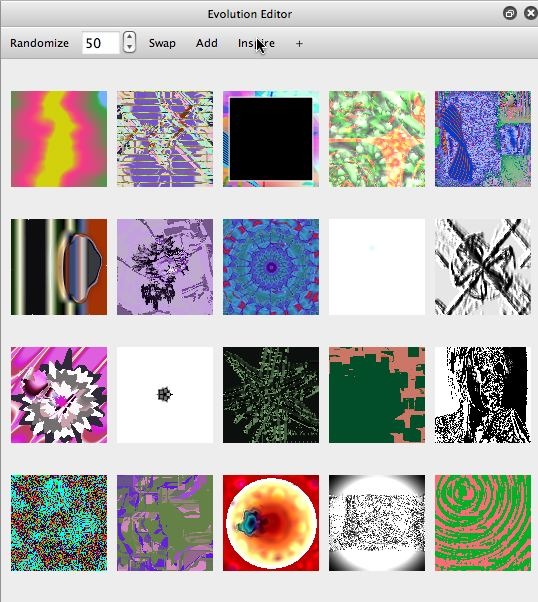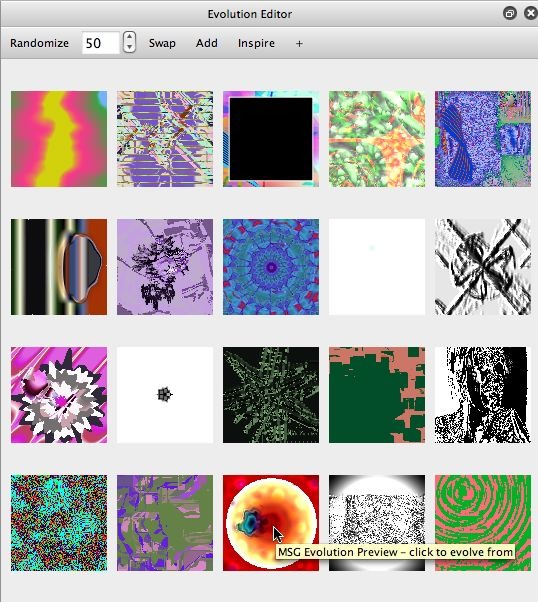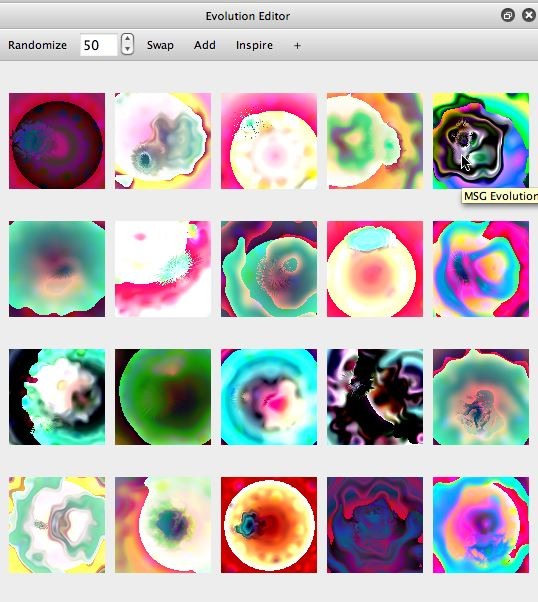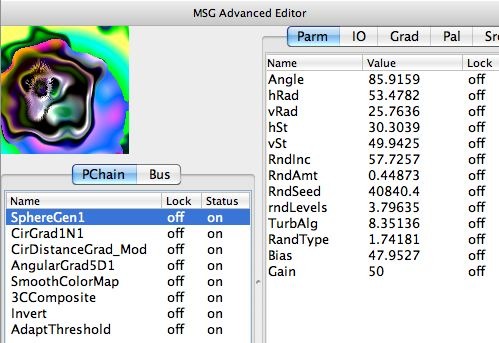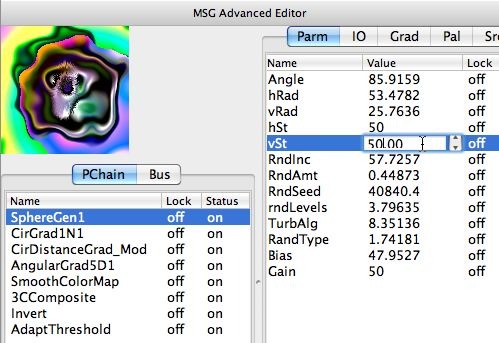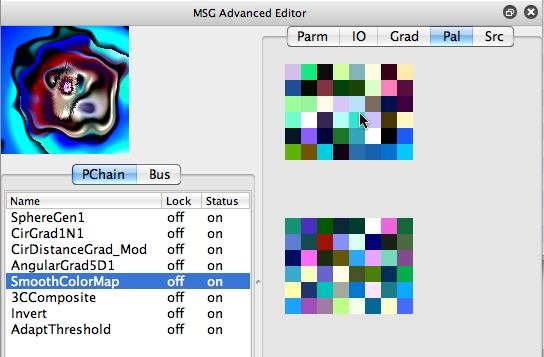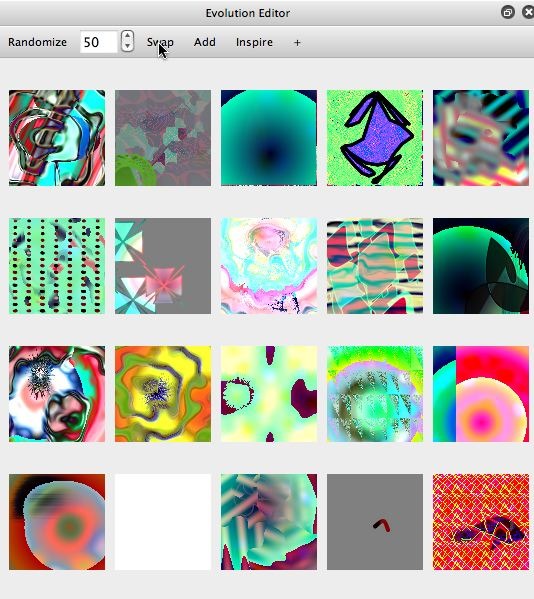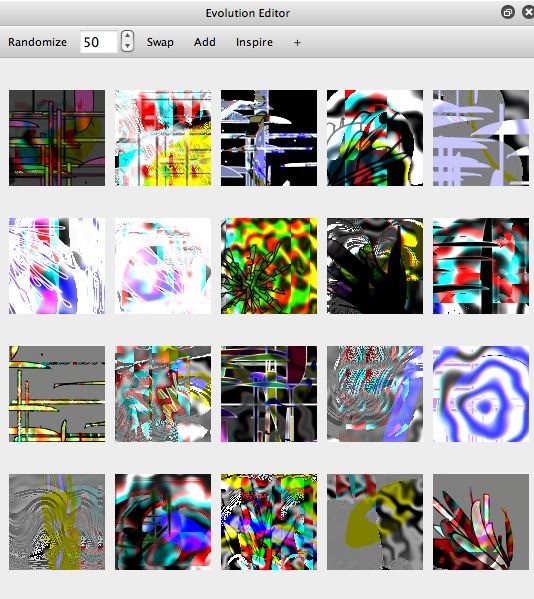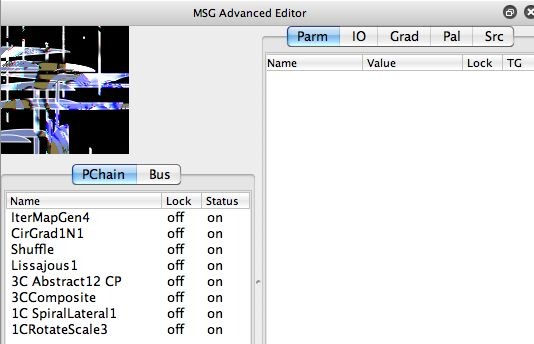The following abstract image was generated working with the MSG Evolution Editor. This post will discuss working with the Evolution Editor to generate new abstract imagery from scratch by using the Inspire button.
The MSG Evolution Editor includes a button in it’s top toolbar labeled Inspire. When you press the Inspire button, the Evolution Editor preview cells are filled with mutated variations of random MSG factory presets. So pressing Inspire leads to an endless stream of new and different random MSG effects.
In a given evolution session, feel free to press Inspire repeatably until you see a preview cell that contains an interesting effect or abstract image. You can then evolve new variations of that effect by clicking on the preview cell of interest.
The first gallery image below shows the state of the evolution preview cells prior to pressing the Inspire button. The second image shows the result of the Inspire evolution. I selected one evolution preview cell I liked and clicked on it to generate mutated variations of the selected effect.
The third gallery image shows the result of clicking on on the preview cell of interest. Note that all of the preview cells are now variations of the last clicked preview cell. I selected the preview cell I liked the best and clicked on the new ‘best of’ preview cell.
The 4th gallery image shows the MSG Advanced Editor after I clicked on the evolution editor preview cell of interest. Note that the preview effect I clicked on is now loaded into the MSG Advanced Editor. I can now do detailed editing of any of the individual editable parameters associated with the individual MSG processors if I wish. I select the processor of interest, and click on the Parm tab in the editor to display the parameter editing tab.
I clicked on the SphereGen1 processor. It contains a number of different editable parameters. The hSt and vSt parameters correspond to the horizontal and vertical center of the generated sphere. I wanted the MSG abstract effect to be centered, so I manually edited those 2 parameters to both be 50%, which centers the procedural sphere.
You can also hold down the t hot key and mouse down in the MSG Advanced Editor preview image to interactively translate a MSG effect. So this would be another interactive way to adjust centering of a moveable effect.
The SmoothColorMap processor uses a color palette to do it’s color mapping effect. So I can modify the coloring of the MSG output by manually adjusting that color map. I did this by selecting the Pal tab to bring up the color palette editing tab. I then held down the h hot key while mousing down in the first color palette, and then moved the mouse to the right to interactively adjust the hue of the color palette. The coloring of the MSG Advanced Editor preview image changed accordingly.
The left side of the status bar at the bottom of the main workspace displays help hints for any control you hold the mouse cursor over, so you can use these help hints as a memory aid for remembering hot key options for different interactive controls.
You can drag and drop any Evolution Editor preview cell to the main canvas if you want to render it into the canvas. Doing this also sets the current MSG preset to the selected preview preset, which accordingly loads it into the MSG Advanced Editor for detailed editing.
We’ve discussed using the Swap toolbar button in the Evolution Editor to generate processor swap mutations in a previous post. Swap evolution works by randomly selecting one of more processors in each preview cell and then swapping them for a second randomly selected processor. The second randomly chosen swap processor is chosen so that it can use the old processor’s IO (input-output) stream connects.
You can also use hotkeys to control the kind of swap evolution you are running. Just pressing the Swap key with no hot key modifiers randomly swaps a single processor. Holding down the option key leads to N random processor swaps, where N is a random number. Holding down the shift hotkey leads to every processor being randomly swapped. You can see the effect of swap, option swap, and shift swap in the 3 gallery images below. Note that they get successively more extreme in the range of effect transformations they generate.
One side effect of generating more effect variation with something like the shift swap is that it may generate a lot of garbage as well. Typically I use normal swap evolution, working with it over time to move through the parameter space landscape to generate new MSG effects. If I feel like i’m getting stuck, or want to make a radical change, then I start using the option swap or shift swap evolution to make radical changes, doing this until I get something I like. I then select the preview cell I like, and start working with Mutate or normal Swap evolution again.
Remember, you can alwas undo a swap evolution to return to your old preview cell images if you dislike what the swap evolution did.
By working with swap evolution over time you can radically change the kind of effects seen in the evolution editor preview cells. The first 2 images in the gallery below show the starting and ending evolution editor preview cells for a series of swap evolutions. the last 2 images show the starting processor chain and the ending processor chain for the beginning MSG preset and the end result MSG preset of the swap evolution session.
Note that the number of processors didn’t change over the course of the swap evolution session. but the specific processors in any given processor list index position have changed dramatically over the course of the swap evolution, leading to the transformation from the original effect to the ending effect generated after the swap evolution session.



